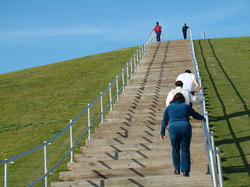Mount Trashmore Park - Virginia Beach, VA

Mount Trashmore Park in Virgina Beach is an excellent example of adaptively re-using land to create recreation and open space. It is also a prime example of the use of parks as an opportunity to rectify environmental problems and utilize green design tactics in the creation and maintenance process. The park is now among the most popular open space and recreation destinations not only within Virginia Beach, but also the larger Hampton Roads region.
The park was officially opened in 1974 on the site of an abandoned landfill. The site of the park was once one of the largest landfills on the East Coast, as trash from up and down the coast was piled into trenches. However, over time it became clear that Virginia Beach could not continue this trash collecting and disposal in perpetuity. It had a short life span, a high economic cost, and was in close proximity to residential neighborhoods. Therefore, an effort was put forth to convert the landfill site into a recreational park, with the centerpiece of the park being its namesake, Mount Trashmore, where an artificial hill was created literally out of trash. A mixture of trash and clean soil form the foundation of the mountain. The mountain is actually on top of flammable gas because as trash decomposes, it naturally emits methane gas. This issue was addressed during the design and creation process, as the mountain and park creators made seven locations at the ground level for gases to escape. Later, hollow poles were jammed deep into the mountain that release the gas at synchronized times.
The mountain stands out from the surrounding geography, which is largely flat coastal plains. The anomaly of a rather large hill in this area therefore attracts attention and increases visitors to and users of the park. From the vantage point of Interstate 264, which abuts northern border of the park, it appears as a large grassy knoll appearing out of the flat residential and developed landscape. However, the park offers much more than that. There are perimeter trails and a large freshwater lake on the opposite of the mountain from the interstate. There is also a mountain trail and lake trail for users to enjoy. One of the main highlights of the park is the 72 steps that climb to the top of the mountain. At the top, park users can enjoy a sweeping vista of not only the park, but the surrounding area as well. There is also a hugely popular 24,000 square foot skate park located within its boundaries. Therefore, the park attracts various users from all walks of life.
As the most visited park in Virginia Beach, Mount Trashmore is certainly a success story. It is also an example that other urban areas can hopefully follow. It is possible to transform a blighted area, a physical eyesore, or an environmentally contaminated site. Virginia Beach turned an environmentally harmful site into one that is green and promotes the health of its citizenry. Other cities have followed this path and will continue to do so as the environmental movement continues to gain traction and the scarcity of developable land will force the re-use of contaminated or abandoned land.
The park was officially opened in 1974 on the site of an abandoned landfill. The site of the park was once one of the largest landfills on the East Coast, as trash from up and down the coast was piled into trenches. However, over time it became clear that Virginia Beach could not continue this trash collecting and disposal in perpetuity. It had a short life span, a high economic cost, and was in close proximity to residential neighborhoods. Therefore, an effort was put forth to convert the landfill site into a recreational park, with the centerpiece of the park being its namesake, Mount Trashmore, where an artificial hill was created literally out of trash. A mixture of trash and clean soil form the foundation of the mountain. The mountain is actually on top of flammable gas because as trash decomposes, it naturally emits methane gas. This issue was addressed during the design and creation process, as the mountain and park creators made seven locations at the ground level for gases to escape. Later, hollow poles were jammed deep into the mountain that release the gas at synchronized times.
The mountain stands out from the surrounding geography, which is largely flat coastal plains. The anomaly of a rather large hill in this area therefore attracts attention and increases visitors to and users of the park. From the vantage point of Interstate 264, which abuts northern border of the park, it appears as a large grassy knoll appearing out of the flat residential and developed landscape. However, the park offers much more than that. There are perimeter trails and a large freshwater lake on the opposite of the mountain from the interstate. There is also a mountain trail and lake trail for users to enjoy. One of the main highlights of the park is the 72 steps that climb to the top of the mountain. At the top, park users can enjoy a sweeping vista of not only the park, but the surrounding area as well. There is also a hugely popular 24,000 square foot skate park located within its boundaries. Therefore, the park attracts various users from all walks of life.
As the most visited park in Virginia Beach, Mount Trashmore is certainly a success story. It is also an example that other urban areas can hopefully follow. It is possible to transform a blighted area, a physical eyesore, or an environmentally contaminated site. Virginia Beach turned an environmentally harmful site into one that is green and promotes the health of its citizenry. Other cities have followed this path and will continue to do so as the environmental movement continues to gain traction and the scarcity of developable land will force the re-use of contaminated or abandoned land.


